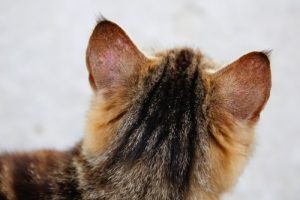Ear lumps in cats
What to do
Causes
When to worry
Prevention
Diagnosis
Home treatment
Vet treatment
Risk
Recommended products
Ear lumps in cats
There are many different types of ear lumps in cats. Lumps can develop on the flap of the ear or inside the canal. Ear lumps can be benign or malignant (can spread). Malignant ear canal tumours are more common in cats compared to dogs, but they are still relatively uncommon. Growths inside the ear canal may be difficult to treat or require referral to a specialist.
Ear lumps can arise from various parts of the ear, such as the skin, the glands that produce oil and wax, and the underlying tissues. Chronic ear inflammation is believed to increase the likelihood of ear canal growths in cats. Any age of cat can be affected, though malignant ear canal growths tend to be more common in middle-aged to older cats.
What to do if your cat has an ear lump
If you notice a swelling or new lump on your cat's ear, it's important to consult a vet as soon as possible. Ear lumps can cause discomfort and may result in self-trauma.
In the meantime:
Try to prevent your cat from rubbing and scratching the ear.
Monitor the size and shape of the lump daily.
If it’s safe to do so, look inside the ear to check for any discharge, redness or growths.
Our Joii vets are available 24 hours a day; call us now if you have any concerns.
The most common causes of ear lumps in cats
Lumps on the ear flap or pinna:
Scabs: from autoimmune disorders, insect bites, nutrient deficiencies or allergies
Mast cell tumour
Folded ear tips
Squamous cell carcinoma
Lumps on the inside the ear canal:
Benign growths from the glands: ceruminous (wax) or sebaceous (oil) gland adenoma
Inflammatory polyp
Foreign body, such as grass seeds
Squamous cell carcinomas
When to worry about ear lumps in cats
An emergency appointment is recommended if your cat:
Develops a head tilt or problems with coordination
Is in severe pain with their ear problem
Develops an ear lump that is growing quickly
A physical examination will be needed if your cat:
Develops a growth or swelling on their ear
Is constantly shaking their head
Develops any pus or blood in the ear canal
Our Joii vets are available for advice 24 hours a day. Call us now if you have any concerns.
Tips on how to prevent ear lumps in cats
While ear lumps are not always preventable, there are some ways to help reduce the risk.
Aural hematomas can result from frequent head-shaking. Prompt and proper treatment of ear infections or irritations can help prevent their occurrence.
Keeping your cat up to date with parasite preventatives can prevent ear mites, mange and ticks.
Ensuring your cat is provided with a well-balanced diet tailored to their age and activity level can help prevent nutrient deficiencies. Special diets are available for cats with allergies, such as Hills Prescription Diet d/d or z/d.
Prolonged inflammation in the ear canal can potentially result in the formation of growths. Proper management of ear infections and addressing underlying allergies can help reduce this risk.
How do you know if your cat has an ear lump?
Lumps may be visible on the ear flap or just inside the ear canal. However, some can be deeper in the canal and may not be visible without a special instrument. Benign lumps often appear as small bumps that stay the same size. Whereas malignant lumps can grow quickly, break open and bleed, resulting in severe pain.
Common signs associated with ear lumps include:
Frequent head-shaking
Scratching or rubbing the ears
Build up of discharge (wax, pus or blood)
Red, inflamed ear canals
Smelly ears

Lumps within the ear canal typically impact only one ear, while infections, nutrient deficiencies, and autoimmune disorders tend to affect both ears. Noticing these symptoms solely in one ear could suggest the presence of a growth within the ear canal.
How to help at home if your cat has an ear lump
Most cases of ear lumps will need immediate veterinary attention. Depending on the cause, it may be recommended to:
Clean your cat's ears regularly with a vet-recommended product.
Check your cat's ears regularly for any abnormalities, such as pus or blood discharge.
Make sure to give any prescribed medication as advised by your vet. If you are struggling, let them know; there may be alternatives.
Vet treatment for ear lumps in cats
The diagnosis and treatment of ear lumps can be tricky. External lumps and swellings are easier to manage, whereas lumps in the canal are more difficult.
Diagnosis may involve:
A thorough examination of the ear canal under anaesthesia
FNA or biopsy of lumps
CT or MRI scan of head and neck for malignant lumps
Staging (checking for spread) may be required for malignant lumps. This can involve blood tests, x-rays and ultrasounds.
Treatment may involve:
Drainage of abscess or haematoma
Surgical removal of lumps: this can be extensive for deep or malignant lumps
Radiation therapy or chemotherapy
Medication: pain relief, antibiotics, or anti-inflammatories.
Are some cats more at risk of ear lumps than others?
Age: Polyps are more common in cats under 5 years old. Benign and malignant tumours are more common in cats that are middle-aged and older.
Persistent inflammation of the ear canal increases the likelihood of growths forming in cats. So, cats with chronic ear infections and underlying allergies may face a bigger risk of developing ear canal tumours.




















